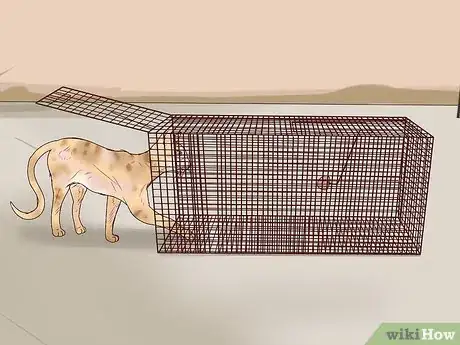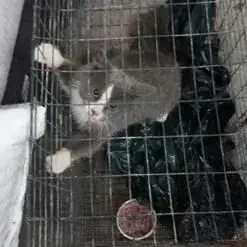This article was co-authored by Molly DeVoss. Molly DeVoss is a Certified Feline Training and Behavior Specialist (CFTBS), a Certified Cat Behavior Consultant (CCBC), a Fear Free Certified Trainer (FFCT), and the Founder of Cat Behavior Solutions. Molly specializes in using positive reinforcement to modify and prevent unwanted behaviors in cats and reduce cat shelter surrender. Molly has sat on the Dallas Animal Advisory committee since 2013 and was voted one of the Top 12 Extraordinary Cat Behaviorists of 2020 by Catpetclub.com. She is certified by both the Animal Behavior Institute and the International Association of Animal Behavior Consultants. She is also the host of the weekly podcast Cat Talk Radio.
There are 7 references cited in this article, which can be found at the bottom of the page.
wikiHow marks an article as reader-approved once it receives enough positive feedback. This article received 24 testimonials and 90% of readers who voted found it helpful, earning it our reader-approved status.
This article has been viewed 487,827 times.
Earning the trust of a stray cat can be a difficult but rewarding process. If you see a stray in your neighborhood that you feel compelled to take in, you must first learn to engage with him in a way that is non-threatening. Know the facts about cat behavior, and what to do and not to do when interacting with strays.
Steps
Making Sure the Cat is Not Feral
-
1Know the difference between a stray and feral cat. When you find a cat outdoors, it's either stray or feral. Dealing with feral cats is very different than dealing with strays, and their trust is sometimes impossible to earn. Before you proceed with approaching the cat, figure out if it's stray or feral.
- Feral cats are born in the wild or outdoors. They have never been pets or lived inside. Stray cats were once pets, but were then lost or abandoned by the owner.[1]
- Feral cats act more wildly than strays, their behavior more akin to raccoons or squirrels. Strays are generally more friendly and approachable, and tend to hang out in residential areas and near homes.[2]
- Stray cats develop feral tendencies if they've been living in the wild for long periods. It can take a long period of one-on-one interaction with a cat to determine if it's stray or feral.[3]
-
2Pay special attention to a cat's behavior and appearance. A cat's behavior and physical qualities offer clues as to whether he was abandoned or born outdoors.
- Disheveled pets are, surprisingly enough, more likely to be strays. Recently abandoned cats have trouble adapting to the wild, and will likely be dirtier and more malnourished than a feral cat.[4]
- Even if a cat runs when you try to pet him, if he approaches you at all he's likely a stray. Feral cats rarely approach humans.[5]
- A sure fire way to determine if a cat is stray or feral is caging the cat. When a stray is caged, he will chirp, rub, play, and raise his tail up in a friendly manner. While feral cats may engage in this behavior outside, especially in the presence of someone who feeds them, they will never indulge the behavior while caged.[6]
Advertisement -
3Be prepared to deal with feral cats. You might find the cat you thought was a stray is actually feral. Feral cats, especially past the age of 7 months, are nearly impossible to domesticate. The ASPCA recommends a policy of Trap, Neuter, Return (TNR) as a humane way to help curb the population of feral cat colonies.
- TNR programs humanely trap feral cats, examine them for medical disorders, provide a series of vaccinations, spay or neuter the cats, and then return them to the wild. Homing feral cats can be a traumatic experience as these cats are essentially wild animals. TNR is generally considered a more ethical option.[7]
- You can set up a TNR program in your area by contacting your local Animal Control, ASPCA, or Humane Society for information. Do not try to deal with feral cats yourself unless you have specific training and experience in regards to handling wild animals. Feral can carry a variety of diseases, including rabies, and behave aggressively when frightened. They should only be handled by animal control professionals.[8]
Luring a Stray Inside
-
1Earn their trust through food. Feeding is the most effective way to get a stray to interact with you.[9] The cat is likely hungry and will respond positively to being fed. This gives you a chance to get closer to the cat and get him used to your presence.
- Select strong smelling food. The easier it is for the cat to detect food, the better. Cats have a strong sense of smell. Canned food is usually more pungent than dry, especially fish flavors like salmon and tuna. However, do not leave human food, such as canned tuna or fish, out for a cat. This can upset a cat's digestive system and you do not want the stray to associate the food you leave with any unpleasantness.
- Leave the food outside in areas where you've seen the stray. Consistency is important. Leave the food in the same place every day and the cat will learn to come to this area when hungry.
- After a few days, stay outside while the cat comes to eat. It may take a week or so for the cat to trust you enough to approach you. Be patient. Do not try to force interaction.[10] [11]
- Do not pet or interact with the cat physically during this time, unless the cat makes contact with you by rubbing against your legs or nuzzling you. Strays have often suffered abuse at the hands of past owners. It may take a stray a long time to warm up to a new person, and they can be easily startled. If you push contact preemptively, the cat might be wary about returning for food.[12] [13]
-
2Select a cat trap. While some strays may walk into someone's home on their own, most strays have trust issues. A humane cat trap is often the best option to get the cat inside your home safely.
- Humane societies often provide safe traps to visitors trying to capture strays. Workers can also explain how to use the traps correctly. The best option is to visit your local shelter and ask them for advice on a cat trap.[14]
- If there is not a shelter in your area, you can purchase cat traps online. Be careful, however, as you want a humane that won't cause the cat discomfort or harm. Check all traps with the ASPCA website to make sure they are humane and safe.[15]
-
3Lure the cat into the trap. A cat will not simply walk into a trap, even if you leave food inside for him. The process of getting the cat safely into the trap takes time.
- When the cat seems comfortable with your presence, start bringing a large crate trap with you when you go to check on him. Ethical traps, that provide no physical harm to the cat, can be found on Amazon or at local pet stores.
- Spend a week or two placing the cat's food closer and closer to the trap. Eventually, put the food just inside the crate but keep the door open while the cat eats. Your goal is to get the cat comfortable being inside the crate so when you latch the door shut the experience is less traumatic.[16]
- Gradually move the food farther into the crate. When you reach the point where the cat is comfortable going all the way in the trap, latch it shut.[17]
-
4Get a veterinary check up. If you want to earn a cat's trust, you need to live with a stray for an extended period. Before you can do this, however, you need to make sure your cat is free from any diseases that could harm you or other pets in your household.
- Before the check up, keep the cat quarantined from other people and animals. Keep him in a closed off room. If possible, a larger crate or cage kept in a heated garage would be the ideal option as the cat may have fleas and ticks that you do not want released into your home.
- Your vet can check your cat for a microchip. This is an identification chip placed underneath the cat's shoulder which can be used to find the owner.[18]
- Your vet will also run a basic physical exam and perform all necessary vaccinations. The cat will also be checked for ailments common among strays, like fleas, heart worm, feline immunodeficiency disorder, and feline leukemia.[19]
Earning Trust at Home
-
1Create a cat room. Taking in a stray is drastically different than taking in a sheltered cat. Your new cat will likely be more timid and more insecure about space and territory. Create a designated cat room so the cat feels comfortable in your home and, in turn, comes to trust you.
- Have supplies like food, water, bedding, toys, and a litter box in place. Anything you can think of to make your cat feel comfortable and secure is a necessity.[20]
- This room should be in a quiet portion of the house and should not be used by humans until your cat has adjusted to his new home. Provide a chair or couch with a blanket hanging over it so your cat has a place to hide when he feels threatened.[21]
- Spend time in the room every day so your cat gets used to your presence. Knock on the door before entering, and say something like "Coming in" in a soft voice.[22]
-
2Respect the cat's boundaries. Stray cats need time to adjust to human interaction. Do not try to force anything too soon, and let your cat take the lead when it comes to interaction.[23]
- Avoid eye contact. Cats often stare at humans, but do not engage in a staring contest with a stray cat. Staring is a sign of aggression. To communicate to your cat that you do not intend to harm him, close your eyes for a few moments and then look away.[24]
- Let the cat approach you. Wait for a cat to make physical contact with you before you attempt to pet him. Cats indicate friendliness by rubbing up against people and gentle nuzzling. Wait until you get such a gesture before trying to touch the cat.[25]
- If your cat wants to hide, let him. He might want to stay under a couch or chair for a few days, only coming out to eat. Allow him to do so, and do not try to coax him out before he is ready.
- When your cat opens up to physical contact, avoid touching his stomach. The stomach is a vulnerable area for a cat and touching it could be a major setback in earning his trust.
-
3Introduce your cat to the household. After your cat has spent a few weeks in his safe room, and seems comfortable in your presence, allow him to explore the rest of the house.
- Let your cat move independently. Allow him to explore the house on his own terms. Keep an eye on him, but do not get in his way too much while he is checking out his new territory.[26]
- If you have other pets, allow them to hear and smell each other before physically interacting. Feed existing pets near the door of your cats safe room. Encourage friendly pawing and playing under the door.[27]
- You can try replacing the door with a temporary screen door, allowing other animals to see the new cat while still providing a physical barrier. This might be helpful if your stray is particularly timid.[28]
- Supervise any initial face-to-face interactions with other pets, watching for signs of aggression.[29]
- Make sure your cat always has access to his safe room so he can go somewhere he feels secure if he wants a place to hide.
Expert Q&A
-
QuestionA stray has been hanging around with my cat. Can I use this to gain the trust of the stray?
 Pippa Elliott, MRCVSDr. Elliott, BVMS, MRCVS is a veterinarian with over 30 years of experience in veterinary surgery and companion animal practice. She graduated from the University of Glasgow in 1987 with a degree in veterinary medicine and surgery. She has worked at the same animal clinic in her hometown for over 20 years.
Pippa Elliott, MRCVSDr. Elliott, BVMS, MRCVS is a veterinarian with over 30 years of experience in veterinary surgery and companion animal practice. She graduated from the University of Glasgow in 1987 with a degree in veterinary medicine and surgery. She has worked at the same animal clinic in her hometown for over 20 years.
Veterinarian For sure. If the stray likes your cat, who then interacts with you in a friendly way, it will give her extra confidence. Try sitting or squatting so you are less imposing, and petting your cat and giving her treats. Ignore the stray, but drop the occasional treat on the ground a little distance away. The stray will see how pleased your cat is with the treats and also make a mental link between you and nice things. This will help speed up the taming process.
For sure. If the stray likes your cat, who then interacts with you in a friendly way, it will give her extra confidence. Try sitting or squatting so you are less imposing, and petting your cat and giving her treats. Ignore the stray, but drop the occasional treat on the ground a little distance away. The stray will see how pleased your cat is with the treats and also make a mental link between you and nice things. This will help speed up the taming process. -
QuestionWhat do I do if a stray cat won't eat its food with me nearby?
 Pippa Elliott, MRCVSDr. Elliott, BVMS, MRCVS is a veterinarian with over 30 years of experience in veterinary surgery and companion animal practice. She graduated from the University of Glasgow in 1987 with a degree in veterinary medicine and surgery. She has worked at the same animal clinic in her hometown for over 20 years.
Pippa Elliott, MRCVSDr. Elliott, BVMS, MRCVS is a veterinarian with over 30 years of experience in veterinary surgery and companion animal practice. She graduated from the University of Glasgow in 1987 with a degree in veterinary medicine and surgery. She has worked at the same animal clinic in her hometown for over 20 years.
Veterinarian The cat is liable to be wary of people, so you need to show you are not a threat. Retreat to a distance at which the cat will eat, and then sit quietly and avoid staring directly at the cat. Repeat this until the cat is regularly eating without hesitation, then shuffle a step closer. Repeat. By being patient and slowly decreasing the distance at which it's happy to eat, you will eventually be able to get close.
The cat is liable to be wary of people, so you need to show you are not a threat. Retreat to a distance at which the cat will eat, and then sit quietly and avoid staring directly at the cat. Repeat this until the cat is regularly eating without hesitation, then shuffle a step closer. Repeat. By being patient and slowly decreasing the distance at which it's happy to eat, you will eventually be able to get close.
Warnings
- Vaccinations are important. Get your strays vaccinated right away after taking them in. Some diseases, such as rabies, are incurable once symptoms begin to show.⧼thumbs_response⧽
- Cats will behave aggressively when threatened, and can carry diseases harmful to humans and other animals. Be very careful handling a stray cat and let them come to you first.⧼thumbs_response⧽
References
- ↑ http://www.petmd.com/cat/care/evr_ct_misunderstood_feral_cat?page=show
- ↑ http://www.petmd.com/cat/care/evr_ct_misunderstood_feral_cat?page=show
- ↑ http://www.petmd.com/cat/care/evr_ct_misunderstood_feral_cat?page=show
- ↑ https://www.aspca.org/pet-care/virtual-pet-behaviorist/cat-behavior/stray-and-feral-cats
- ↑ https://www.aspca.org/pet-care/virtual-pet-behaviorist/cat-behavior/stray-and-feral-cats
- ↑ https://www.aspca.org/pet-care/virtual-pet-behaviorist/cat-behavior/stray-and-feral-cats
- ↑ https://www.aspca.org/pet-care/virtual-pet-behaviorist/cat-behavior/stray-and-feral-cats
- ↑ https://www.aspca.org/pet-care/virtual-pet-behaviorist/cat-behavior/stray-and-feral-cats
- ↑ Molly DeVoss. Certified Feline Training and Behavior Specialist & Certified Cat Behavior Consultant. Expert Interview. 28 June 2021.
- ↑ Molly DeVoss. Certified Feline Training and Behavior Specialist & Certified Cat Behavior Consultant. Expert Interview. 28 June 2021.
- ↑ https://www.aspca.org/pet-care/virtual-pet-behaviorist/cat-behavior/stray-and-feral-cats
- ↑ Molly DeVoss. Certified Feline Training and Behavior Specialist & Certified Cat Behavior Consultant. Expert Interview. 28 June 2021.
- ↑ https://www.aspca.org/pet-care/virtual-pet-behaviorist/cat-behavior/stray-and-feral-cats
- ↑ http://bestfriends.org/Resources/No-Kill-Resources/Cat-initiatives/Helping-Community-Cats/Humane-Trapping-Instructions-for-Community-Cats/
- ↑ http://bestfriends.org/Resources/No-Kill-Resources/Cat-initiatives/Helping-Community-Cats/Humane-Trapping-Instructions-for-Community-Cats/
- ↑ https://www.aspca.org/pet-care/virtual-pet-behaviorist/cat-behavior/stray-and-feral-cats
- ↑ https://www.aspca.org/pet-care/virtual-pet-behaviorist/cat-behavior/stray-and-feral-cats
- ↑ https://www.aspca.org/pet-care/virtual-pet-behaviorist/cat-behavior/stray-and-feral-cats
- ↑ https://www.aspca.org/pet-care/virtual-pet-behaviorist/cat-behavior/stray-and-feral-cats
- ↑ http://moderncat.com/articles/5-ways-help-semi-feral-cat-adjust-domestic-home/68600
- ↑ http://moderncat.com/articles/5-ways-help-semi-feral-cat-adjust-domestic-home/68600
- ↑ http://moderncat.com/articles/5-ways-help-semi-feral-cat-adjust-domestic-home/68600
- ↑ Molly DeVoss. Certified Feline Training and Behavior Specialist & Certified Cat Behavior Consultant. Expert Interview. 28 June 2021.
- ↑ http://moderncat.com/articles/5-ways-help-semi-feral-cat-adjust-domestic-home/68600
- ↑ http://womanitely.com/important-tips-adopting-stray-cat/
- ↑ http://womanitely.com/important-tips-adopting-stray-cat/
- ↑ http://www.paws.org/library/cats/home-life/introducing-cat-to-cat/
- ↑ http://www.paws.org/library/cats/home-life/introducing-cat-to-cat/
- ↑ http://www.paws.org/library/cats/home-life/introducing-cat-to-cat/
About This Article
To earn the trust of a stray cat, leave strong-smelling cat food outside where you’ve seen the stray, at the same time every day. After a few days, stay outside while the cat comes to eat, but don’t approach it yet. Once the cat begins to trust you, get a humane cat trap from your local humane society, and leave it outside. For a couple weeks, move the food closer and closer to the cat trap, until the cat is comfortable going all the way in. To learn our Veterinary reviewer’s advice on how to get your stray used to being part of the household, keep reading!






































































